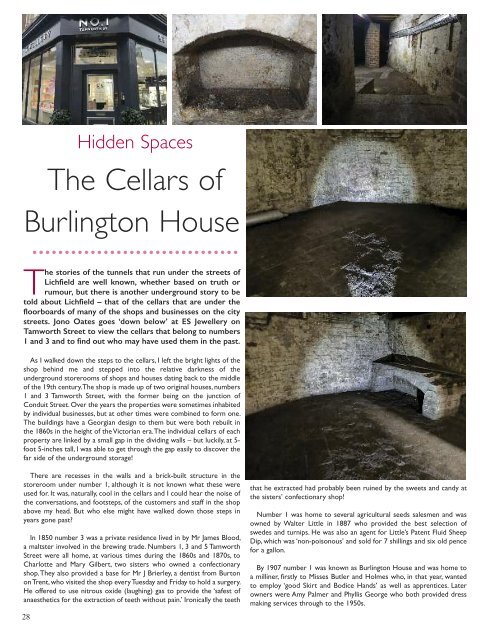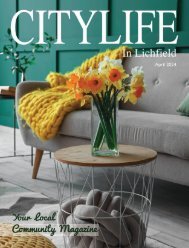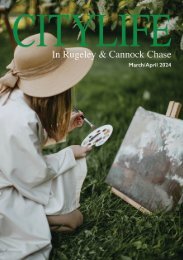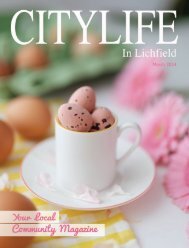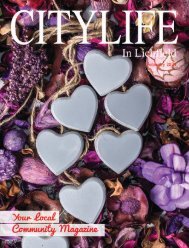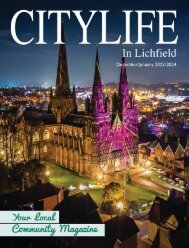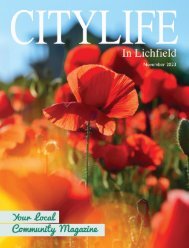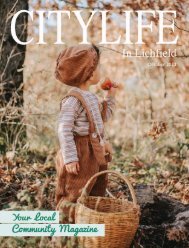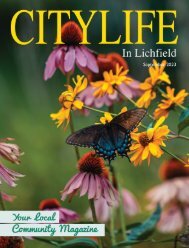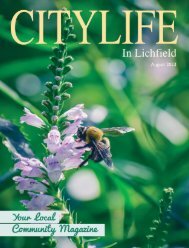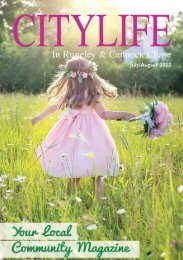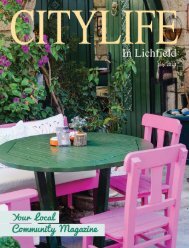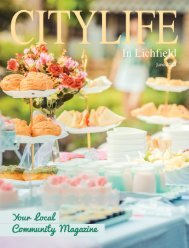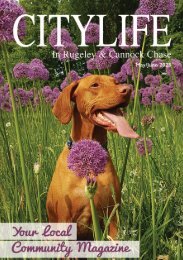Citylife in Lichfield February 2020
Love is definitely in the air in our February Valentine's Special edition! All the usual news, views, articles, competitions, recipes and history features are all here in this edition of Citylife in Lichfield - everything you want to know, explore and learn about Lichfield in one magazine!
Love is definitely in the air in our February Valentine's Special edition! All the usual news, views, articles, competitions, recipes and history features are all here in this edition of Citylife in Lichfield - everything you want to know, explore and learn about Lichfield in one magazine!
Create successful ePaper yourself
Turn your PDF publications into a flip-book with our unique Google optimized e-Paper software.
Hidden Spaces<br />
The Cellars of<br />
Burl<strong>in</strong>gton House<br />
................................<br />
The stories of the tunnels that run under the streets of<br />
<strong>Lichfield</strong> are well known, whether based on truth or<br />
rumour, but there is another underground story to be<br />
told about <strong>Lichfield</strong> – that of the cellars that are under the<br />
floorboards of many of the shops and bus<strong>in</strong>esses on the city<br />
streets. Jono Oates goes ‘down below’ at ES Jewellery on<br />
Tamworth Street to view the cellars that belong to numbers<br />
1 and 3 and to f<strong>in</strong>d out who may have used them <strong>in</strong> the past.<br />
As I walked down the steps to the cellars, I left the bright lights of the<br />
shop beh<strong>in</strong>d me and stepped <strong>in</strong>to the relative darkness of the<br />
underground storerooms of shops and houses dat<strong>in</strong>g back to the middle<br />
of the 19th century. The shop is made up of two orig<strong>in</strong>al houses, numbers<br />
1 and 3 Tamworth Street, with the former be<strong>in</strong>g on the junction of<br />
Conduit Street. Over the years the properties were sometimes <strong>in</strong>habited<br />
by <strong>in</strong>dividual bus<strong>in</strong>esses, but at other times were comb<strong>in</strong>ed to form one.<br />
The build<strong>in</strong>gs have a Georgian design to them but were both rebuilt <strong>in</strong><br />
the 1860s <strong>in</strong> the height of the Victorian era. The <strong>in</strong>dividual cellars of each<br />
property are l<strong>in</strong>ked by a small gap <strong>in</strong> the divid<strong>in</strong>g walls – but luckily, at 5-<br />
foot 5-<strong>in</strong>ches tall, I was able to get through the gap easily to discover the<br />
far side of the underground storage!<br />
There are recesses <strong>in</strong> the walls and a brick-built structure <strong>in</strong> the<br />
storeroom under number 1, although it is not known what these were<br />
used for. It was, naturally, cool <strong>in</strong> the cellars and I could hear the noise of<br />
the conversations, and footsteps, of the customers and staff <strong>in</strong> the shop<br />
above my head. But who else might have walked down those steps <strong>in</strong><br />
years gone past?<br />
In 1850 number 3 was a private residence lived <strong>in</strong> by Mr James Blood,<br />
a maltster <strong>in</strong>volved <strong>in</strong> the brew<strong>in</strong>g trade. Numbers 1, 3 and 5 Tamworth<br />
Street were all home, at various times dur<strong>in</strong>g the 1860s and 1870s, to<br />
Charlotte and Mary Gilbert, two sisters who owned a confectionary<br />
shop. They also provided a base for Mr J Brierley, a dentist from Burton<br />
on Trent, who visited the shop every Tuesday and Friday to hold a surgery.<br />
He offered to use nitrous oxide (laugh<strong>in</strong>g) gas to provide the ‘safest of<br />
anaesthetics for the extraction of teeth without pa<strong>in</strong>.’ Ironically the teeth<br />
28<br />
that he extracted had probably been ru<strong>in</strong>ed by the sweets and candy at<br />
the sisters’ confectionary shop!<br />
Number 1 was home to several agricultural seeds salesmen and was<br />
owned by Walter Little <strong>in</strong> 1887 who provided the best selection of<br />
swedes and turnips. He was also an agent for Little’s Patent Fluid Sheep<br />
Dip, which was ‘non-poisonous’ and sold for 7 shill<strong>in</strong>gs and six old pence<br />
for a gallon.<br />
By 1907 number 1 was known as Burl<strong>in</strong>gton House and was home to<br />
a mill<strong>in</strong>er, firstly to Misses Butler and Holmes who, <strong>in</strong> that year, wanted<br />
to employ ‘good Skirt and Bodice Hands’ as well as apprentices. Later<br />
owners were Amy Palmer and Phyllis George who both provided dress<br />
mak<strong>in</strong>g services through to the 1950s.


